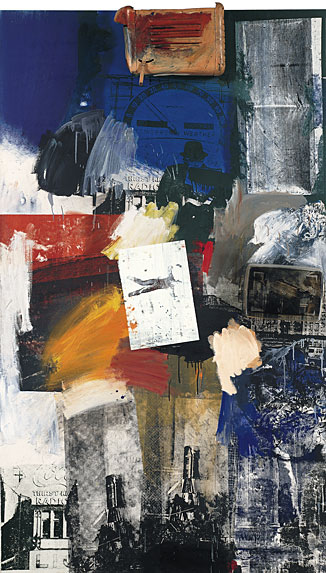TIME.COM – Appreciation
Robert Rauschenberg, 1925-2008
Tuesday, May. 13, 2008 By RICHARD LACAYOIt may be the least of the many things that Robert Rauschenberg will be remembered for. But as we sum up the great legacy of the artist who died this week at 82, let’s pause to remember that in 1983 he won a Grammy Award for the cover of the Talking Heads album Speaking in Tongues. That feels about right. It’s hard to think of a better match for Rauschenberg, a one man principle of creative disorder, than the band that gave us the line: «Stop making sense.»
What he passed on to everyone who came after was an idea of art as a very free-wheeling transaction with the world. Marcel Duchamp may have staked out something like this position sooner, but Rauschenberg gave it a more raucous charm. That so many artists have used it since as permission to make lazy, slapdash work is beside the point. Frequently so did he. But every time you see anyone doing anything that isn’t supposed to be art — and calling it art — Rauschenberg is there.
[Robert Rauschenberg – Wikipedia]
Rauschenberg ha sido uno de los artistas visuales que han influenciado la música y el arte sonoro desde mediados del siglo XX. Pego aquí unos fragmentos acerca de estas conexiones, extraídos del libro Sound Art: Beyond Music, Between Categories, de Alan Licht.
Robert Rauschenberg´s Combines have exerted a supreme influence on postmodernism that is certainly felt in the genre slice-and-dice of fre improvisations of AMM (a British group who would improvise noisy soundscapes on top of loops of Beach Boys´ songs) or Christian Marclay (whose ability to careen from lounge music to classical to Jimi Hendrix on his multiple turntables in turn influenced composer John Zorn). But Rauschenberg also exerted a major influence on many auteurs inthe musci world of the ´40s and ´50s
Rauschenberg´s white paintings were particularly influential on Cage´s 4´33″ : «When I saw those I said ‘Oh yes, I must; otherwise I´m laging, music is lagging.»
Karlheinz Stockhausen also cites the unifying found objects in Rauschenberg´s Combines as an influence on his Kontakte and Gesang der Junglinge. Rauschenberg was an influence on Feldman´s later piece The Viola in My Life –«My intention was to think of melody and motivic fragments,» he wrote, «somewhat the way Robert Rauschenberg uses photographs in his painting– and superimpose this on a static sound world more characteristic of my music.» And Steve Reich´s determination to break with musique concrete and present taped sounds as they were, unprocessed, recalls Rauschenberg´s popstmodernist decision to leave imagery recognizable in his collages (although Reich´s integration of African music into his composition would be more comparable to the influence of African tribal art on Picasso). Indeed Rauschenberg´s famous quote about operating in the gap between life and art becomes increasingly influential even five decades later and is certainly responsible for the cceptance of daily environment sounds into an installation situation.

** Robert Rauschenberg’s untitled ‘combine’, 1963.
Oil, silkscreened ink, metal, and plastic on canvas.

Leave a Reply
Lo siento, debes estar conectado para publicar un comentario.